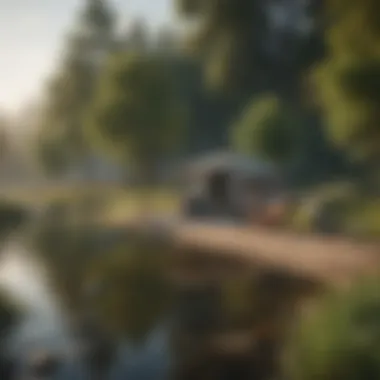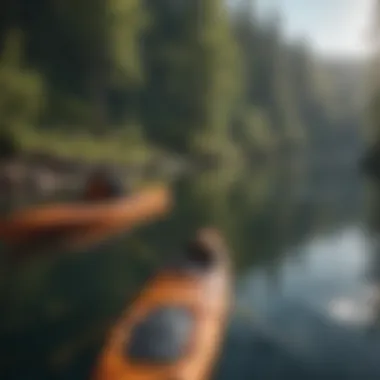Explore Lakeside Campsites: A Complete Guide to Nature


Overview of the Topic
Camping by lakes presents unique opportunities and challenges. Lakes serve as significant natural resources that help sustain ecosystems while providing recreational spaces for people. Environmental issues, particularly surrounding the conservation of lakes, are increasingly vital. These areas provide not only beauty but also diverse habitats for wildlife. The surge in camping near lakes raises important discussions about sustainability, resource management, and protecting these natural environments.
Preamble to Lakeside Camping
Lakes are often focal points for outdoor activities. Their beauty is hard to resist. People flock to these areas for swimming, fishing, and hiking. With increased activity, it becomes essential to understand how our presence affects these ecosystems. Proper awareness about camping practices plays a crucial role in minimizing human impact. Ensuring the preservation of lakes helps maintain these vibrant ecosystems for future generations.
Significance of Maintaining Lake Ecosystems
Lakes impact local climate and wildlife. They support various species, both plants and animals. The health of lake ecosystems reflects broader environmental conditions. Focusing on lakeside camping supplies can improve not only individual experiences but also promote preservation tactics widely. Facilities that offer campsites close to lakes help communities engage with nature. Such experiences create bonds between individuals and the environment.
Current Status and Challenges
The popularity of lakeside camping introduces challenges. Overcrowding and pollution emerge as pressing concerns. Heavy foot traffic erodes trails and campsites, degrading the landscape. Chemicals and waste end up in the water, threatening aquatic life and influencing human health. Understanding these current realities is necessary for proactive measures.
Examination of Current Conditions
Lakes across the globe face numerous pressures. Many suffer from eutrophication due to nutrient overload from agricultural runoff. This microbial bloom not only reduces water quality but also depletes oxygen levels in the lake. Furthermore, the migration patterns of fish decrease, impacting local fishing opportunities for communities. Watershed management practices need reassessment to combat these problems.
Challenges Facing Lakeside Environments
- Pollution from campsite activities
- Invasive species disrupting native habitats
- Mismanagement of resources and facilities
- Pressure from climate change causing habitat loss
These challengers require attention to maintain lakes' ecological integrity. It becomes clear that camping practices can either contribute to symptom resolution or exacerbate these issues further.
Sustainable Solutions
Awareness of the ecological footprint we leave behind pushes the need for sustainable camping solutions. Strategically implemented measures can reverse adverse changes and ultimately benefit communities reliant on healthy ecosystems.
Exploration of Sustainable Practices
- Leave No Trace Principles: Practicing respect for nature is crucial. Campers should be mindful about cleaning up thoroughly and leaving sites as they found them.
- Wildlife Conservation Efforts: Participation in local wildlife conservation initiatives engages campers and promotes stewardship.
- Education and Awareness: Offering workshops around sustainable practices helps foster understanding.
- Road Maintenance ensuring mild disturbances to surrounding foliage and ecosystems.
These simple practices can lead to effective lake preservation strategies.
Successful Case Studies
- Banff National Park's Eco-Friendly Campsites: This park allows fewer visitors and promotes education among campers.
- Lake Tahoe Basin's Management Strategy: Strict regulations promoted clearing up sites. After implementing careful monitoring of wildlife, people noticed sustained benefits over time.
These are but a few examples that show how intentional actions lead to improved lakeside health.
Impact and Importance
The implications of how we treat lakes expounds beyond campgrounds. They significantly influence local biospheres, communities relying on fishing, tourism, and aesthetics. Protecting lakes guarantees ecological security for countless generations to come.
Analyzing the Broader Effects
As ecosystems fall apart, so do local economies and communities, increasing pressures on urban centers. Informing communities about lakeside issues encourages proactive participant behavior in safeguarding resources. Resilient ecosystems balance beneficial human enjoyment alongside nature's essential role.
Preserving our lakes is not merely an environmental duty; it is a fundamental responsibility towards humanity's collective future.
Emphasizing Conservation
Too often overlooked, conservation efforts quieten concerns pervasive nature face today. By prioritizing conservation and sustainable uses of lakes, we encourage diverse interactions. The importance of initiating dialogue around these topics cannot be overstated. The previous sections act as a comprehensive guide toward becoming an informed camper, cultivating deeper appreciation and responsibility toward our natural resources.
Intro to Lakeside Camping
Lakeside camping offers an escape into nature, merging the soothing properties of water with the tranquility of wooded surroundings. This article delves into the various dimensions of lakeside campgrounds, importance of their preservation, and the diverse experiences they provide. Understanding the distinctive character of lakeside camping helps emphasize its significance not just as a recreational pursuit, but also as a way to appreciate and protect our ecosystems.


The Appeal of Lakeside Campgrounds
Lakeside campgrounds attract campers for myriad reasons. One primary factor is undoubtedly the natural beauty. The sight of placid waters reflecting the sky offers a calming backdrop. It is ideal for relaxation and helps rejuvenate mental health. Additionally, the proximity to water bodies enhances recreational opportunities.
Water activities vary from canoeing and kayaking to fishing, swimming, and simply taking a scenic view. Many campers find lakeshores convenient for setting up their gear. This ease prompts families and individuals alike to choose lakeside locations over traditional campgrounds.
Other appeals include the biodiversity of lakeside regions. Many organisms thrive near water. This diversity enriches the camping experience as one can observe both aquatic and terrestrial creatures. Birdwatching, for example, is a popular activity among campers who wish to study local wildlife. Thus, these environments present a beautifully interlinked ecosystem that captivates many outdoor enthusiasts.
Historical Perspective on Lake Camping
Camping by lakesides is not a modern phenomenon; it has deep historical roots. Primitive societies often settled near water for sustenance and safety. As civilizations evolved, the fascination with lakes persisted. The Victorian era, in particular, saw a surge of interest in nature retreats, leading to the establishment of campgrounds specifically designed for leisure and outdoor activities near lakes.
In the late 19th century, camping became more mainstream as transportation improved. Railways extended into the wilderness, making it easier for people to access remote settings. The establishment of national parks and organized camping groups further popularized this activity.
Today, lakeside camping continues to evolve while honoring its origins. The merging of outdoor recreation with educational aspects helps promote stewardship in protecting these natural areas. Understanding its rich history clarifies why lakeside camping remains a cherished practice for so many.
Top Lakeside Campsites
Finding the right lakeside campsite is crucial for individuals seeking the full experience of nature and outdoor living. Lakeside campgrounds offer unique perks that enhance the camping adventure. These sites allow campers to embrace aquatic recreation, scenic views, and an element of tranquility unique to lake environments. Choosing the right type of campground can greatly enhance the overall enjoyment of your trip.
National Parks with Lakeside Campgrounds
National parks are often the first choice for those interested in camping by a lake. Parks like Yellowstone and Glacier National Park feature well-maintained campgrounds with direct access to dazzling lake views. These campsites not only provide essential amenities but also position visitors near vibrant wildlife and stunning natural framed by mountains, trees and clear water.
Some parks even have visitor centers, making it easier to familiarize oneself with the local ecology. However, it is important to plan ahead, as popular sites often require reservation months in advance, especially during peak seasons.
Benefits of National Park Campgrounds
- Natural Beauty: Campers can experience stunning landscapes.
- Protected Areas: These locations are typically safeguarded, ensuring some level of environmental stability and wildlife conservation.
- Recreational Activities: Options such as hiking, fishing, and nature photography abound.
Private Campsites and Their Unique Offerings
While national parks are celebrated, private campsites present a different charm. Private campgrounds often offer enhanced facilities such as cabins, organized activities, and sometimes services like kayak rentals. These campsites can be less crowded than public ones and often provide amenities that some campers may appreciate, like modern toilets and access to camp stores.
What to Expect
- Personalized Experience: Private campsites may have the capacity to offer an individualized camping experience, catering to different needs and desires.
- Flexibility: These sites often allow more leeway regarding check-in and check-out times.
- Unique Attractions: Some private campsites may stand out by providing exclusive options, such as workshops on outdoor skills.
State Park Campgrounds: A Closer Look
State parks contain diverse lakeside campgrounds that can be a great option for average campers. Many state parks often feature fewer crowds and relatively accessible pricing when compared to national parks. They usually cater to local residents and neighboring states, offering shorter drives to stunning locations. Their ecosystems can be just as captivating, with opportunities for fishing, picnicking, and exploring trails without immense tourist traffic.
Considerations for State Parks
- Budget-friendly: Camping fees at state parks can represent significant savings.
- Accessibility: Most parks offer well-marked campgrounds and easier access to amenities.
- Variety of Options: State parks may have options ranging from basic tent camping to fully equipped RV spots.
Exploring different types of lakeside campsites, including the array from national parks to private installations and state parks, grants the outdoor enthusiast numerous choices. Each type offers an array of benefits and considerations that cater to varying preferences and budgets.
Activities Available at Lakeside Campsites
When examining those camping options available by lakes, the activities offered at these sites become crucial. Engaging in diverse pastimes not only enriches the camping experience but also connects visitors with nature. Lakeside campgrounds cater to various interests, from relaxation to adventure. Moreover, the kind of activities you choose can impact your awareness of environmental considerations and your impression of the natural world.
Water-based Recreational Opportunities
Fishing
Fishing is perhaps one of the most classic activities to engage in by a lake. It offers a serene experience that attracts those valuing solitude and nature. One key aspect of fishing is that it promotes patience and respect for aquatic ecosystems.
The charm of fishing lies in its simplicity yet complexity. Anglers appreciate honing their skills, selecting the right bait, and learning about local fish species. Importantly, fishing can also be a beneficial leisure activity, allowing individuals to interact with nature in a calming manner. Most lakes offer a variety of species from trout to bass. However, understanding the importance of sustainable fishing practices is critical to ensure fish populations remain healthy.
Kayaking and Canoeing


When utilizing lakes for recreational watercraft, kayaking and canoeing stand out as activity choices favored by many campers. Both activities provide excellent physical exercise sprinkled with moments of tranquility as you paddle across calm waters, admiring the views.
The notable aspect of kayaking and canoeing is their accessibility. From families to seasoned adventurers, they can be enjoyed by almost anyone. This accessibility contributes to their popularity, promoting outdoor enthusiasm and exploration. Exploring secluded corners of lakes is a unique experience, too. However, safety precautions must be taken, especially when it involves less experienced paddlers or unfavorable weather conditions.
Swimming
Another prominent water activity available at lakeside campsites is swimming. The wide appeal of swimming lies in its approach to refreshment and leisure. Lakes provide diverse swimmable areas suited to various skill levels, from shallow shores to deeper waters.
Swimming is easily a communal experience, drawing families and friends together, reinforcing social bonds. It can be enjoyable and relaxing but has disadvantages, such as challenges related to water safety and the potential risk of encountering harmful wildlife or contaminants. This emphasizes the need for awareness and reassurance regarding water quality prior to entering the lake.
Land-based Activities
Hiking Trails Around Lakes
Hiking trails near lakes offer exemplary paths that lead through picturesque landscapes. They connect copious environments, integrating natural features like forests and the lakeside itself.
One distinct feature of these hiking trails is variability. Often categorized by various degrees of difficulty, there is an accessible option for everyone. Hiking promotes physical health while encouraging adventures into often hidden landscapes. It enhances appreciation for natural beauties like flora and fauna observed along the paths. However, hikers must tread carefully, respecting mutable environments to preserve them for future visitors.
Wildlife Viewing
Wildlife viewing presents both an enriching recreational experience and a learning opportunity when camping at lakesides. This activity provides opportunities for appreciation of local fauna and creating a connection with the ecosystem.
The engaging characteristic of wildlife viewing is the excitement of seeing different species in their natural habitats. Different animals frequent lakeside areas, including birds, deer, and smaller mammals. But, it’s essential to approach wildlife with respect and caution. Disturbing their habitats will disrupt their natural behaviors and might lead to harm.
Photography and Nature Walks
Photography at lakeside campsites has grown significantly as an activity alongside nature walks. As many seek to capture the stunning beauty of their surroundings, the integration of creative expression and exploration arises.
The easily observed element in photography is its capacity to freeze moments in time, offering campers lasting memories. Taking photos often leads wildlife enthusiasts or budding photographers to carefully study their environments. However, becoming potentially invasive or disturbing wildlife while engaging in such pursuits is a downside. It remains vital to ensure your practices align with conservation ethics, prioritizing both an enjoyable experience and environmental integrity.
Engaging with the variety of activities available near lakes expands both physical pursuits and contemplative moments. Understanding how these activities impact the environment raises awareness of our natural responsibilities and fosters a desire for sustainable practices.
Environmental Considerations of Lakeside Camping
Understanding the environmental considerations of lakeside camping is critical for both preservation of the local ecosystems and for future enjoyment of these beautiful sites. Lakeside camping offers not just a chance to reconnect with nature, but also a platform to evaluate our impact on these fragile environments. Responsible camping reduces human disturbance and protects these ecosystems long term. Here we will explore some discussed aspects of environmental considerations that anyone embarking on such a trip should be aware of.
Impact on Local Ecosystems
Camping near lakes affects local ecosystems in varied ways. Development of campgrounds disrupts natural habitats. This can lead to a decline in the populations of native flora and fauna. Moreover, increased human activity near water bodies can raise pollution levels. Waste disposal technologies or lack thereof sadly impact the clear waters we appreciate. Chemical pollutants may leech into groundwater. Invasive species introduced by careless actions can outcompete native species, resulting in poorer biodiversity.
Ultimately, understanding these impacts is important for minimizing them. Outdoor enthusiasts should prioritize more sustainable practices that benefit everyone.
Sustainable Camping Practices
Leave No Trace Principles
Leave No Trace principles focus on promoting responsible outdoor ethics. It’s about minimizing the digital and physical footstep you leave. This includes practices like packing out trash, making a small campfire only in designated spots, and avoiding picking plants. The primary characteristic of Leave No Trace is its emphasis on preservation through education. This provided a lot of value as camping becomes trendy for new generations exploring outdoor settings.
This approach offers clear advantages. Not only does it protect the landscapes but additionally encourages campers to reflect on their impact.
“Practicing Leave No Trace properly harmonizes outdoor life with a sustained view on nature.”
Water Conservation Techniques
Water conservation techniques relate directly to the effective use of resources. As shelters are often near lakes, campers should consider their usage of water carefully. This includes measures like using biodegradable soaps, which protect the purity of natural water bodies. Methods such as collecting rainwater can add additional layers of conservation practices.
The focus on kitchen or washing setups that prevent runoff stabilizes ecosystem integrity. Disturbing grass does not erase Manchester-derived lawns, so educated awareness is needed.
Wildlife Protection Protocols


Wildlife protection protocols help in the safeguarding of local species. Understanding the importance of maintaining safe distances from wild animals is key. These protocols encompass no feeding or provoking wildlife. Such regulations ensure animals retain their natural behaviors and habitats remain pristine.
Without positive practices from the community perspectives Route weather events can spoil camping trips.
Through these guidelines, campers not only enjoy their experience but also take affirmative action toward conservation. Each tiny step enhances long-term results that benefit wildlife and lakeside environments.
By integrating these considerations into their camping routines, enthusiasts contribute towards an ecologically-sound relationship with mother nature. This provides not only personal enrichment but the broader shared responsibility of stewardship for future generations.
Preparation for a Lakeside Camping Trip
Lakeside camping can be a profound experience, connecting you directly with nature. However, preparing properly is critical. A well-planned trip enhances enjoyment and minimizes risks related to weather and safety. Understanding this preparation phase allows campers to focus on the tranquility and beauty found at lakeside locations, making the journey not only enjoyable, but also safe and sustainable.
Essential Gear and Pack List
When getting ready for lakeside camping, having the right equipment is vital. The outdoor environment has specific needs that differ from a typical camping trip. Here’s a comprehensive list to ensure you have essentials covered:
- Tent: Choose one that can withstand local weather conditions. Ensure it is easy to set up.
- Sleeping Bag: Pick one that suits temperatures of your destination. Insulation is key.
- Cooking Gear: Bring a portable stove and necessary utensils. Don't forget fuel!
- Water Filtration System: Clean drinking water is crucial. Familiarize yourself with your method in advance.
- Clothing: Layers are important. Bring rain gear and appropriate footwear, as conditions can change quickly.
- First Aid Kit: Prepare for emergencies. A kit can range from minor cuts to larger injuries.
- Navigation tools: Maps and compasses or GPS devices can assist in exploration.
By ensuring you have these essential items, you can engage with the environment and focus on activities available at the lakes and surrounding areas.
Understanding Weather Patterns
The weather at lakes can be unpredictable. For those planning a lakeside camping trip, grasping weather patterns is an important skill. Conduct thorough research concerning average temperatures for the timeframe you plan to visit. Daily forecasts cannot always anticipate sudden changes.
- Temperature Variations: Be mindful that temperatures may vary between day and night, so ensure your gear accommodates both.
- Local Climates: Different lakes in various geographical locations can exhibit distinct climate behaviors. Examine dynamics like wind patterns or humidity impact.
- Seasonal Changes: Certain times of the year bring heavy rain or storms. Knowledge of these seasonal shifts will help avoid dangerous conditions.
Staying informed doesn’t only enhance comfort. It significantly increases safety while exploring lakeside areas.
Understanding weather can prevent cold nights and prepare for surprise downpours. Familiarity with seasonal patterns allows easier navigation when planning activities outdoors. It is often overlooked yet profoundly impacts the overall experience at a lakeside campsite.
Regulations and Reservations
Understanding the regulations and reservation processes when planning a lakeside camping trip is crucial for both enjoyment and ecological preservation. Adhering to the local laws and reservation protocols ensures streamlined access to these natural resources while minimizing impact. In essence, this section will clarify how to navigate the complex landscape of campsite management, ensuring a pleasant and lawful experience.
Site Reservation Process
The site reservation process varies by location, yet some fundamental principles apply universally. Before embarking on your trip, one must consider how to secure a spot effectively to prevent any misunderstandings or disruptions on arrival. Common methods include:
- Online Booking: Many campgrounds offer online reservation systems, which allow for real-time availability checks. This is often the easiest and most efficient approach. Websites belonging to national or local park services serve as valuable tools in this search.
- Phone Reservations: For those who may prefer a more personalized approach or face any potential technical errors online, calling directly to the intended campsite can clarify availability details.
- Walk-In Reservations: While not recommended during peak seasons, arriving at the campsite and requesting a spot may succeed, contingent on overcrowding conditions.
“Planning ahead is the identifier of a successful adventure—don’t leave it to chance.”
Reservations help manage visitor loads and protect the environment from being overwhelmed, directly supporting sustainable practices at campsites. Ensuring a reservation is made well in advance—especially during busy weekends—can prevent disappointment. This combined approach encourages respect for natural habitats and local wildlife while making your lakeside experience enjoyable.
Understanding Local Regulations
The specific local regulations that govern lakeside campsite activities can generally encompass several categories acutely pivotal in the overall camping experience. Familiarizing oneself with these regulations not only protects the camping experience but also underscores responsibility towards the ecosystem. Common regulations may include:
- Fire Restrictions: Many sites strictly require campfires only in designated areas to prevent forest fires. Ensure you inquire about these rules, including any seasonal bans, prior to starting a fire.
- Wildlife Interactions: Regulations exist to protect both visitors and wildlife. Keeping distances from animals, storing food properly, and understanding what to do in wildlife encounters is critical for safety.
- Waste Management: Campsites frequently stipulate strict rules regarding waste disposal. Familiarize yourself with procedures for trash disposal or recycling which, in turn, contribute to ecological preservation.
- Fishing and Swimming: Specific sites may apply rules about fishing licenses or swimming safety—noting hours when fishing is legal and reserved locales where swimming is permitted.
Being aware of local knowledge is yourself as a conscientious visitor. Many parks or campsites release brochures or maintain website content detailing standard visitor expectations, a practice explicitly fundamental for those involved in conservation and preserving natural habitats. Prioritizing compliance fosters communal respect among campers and enlightenment further down the line for other visitors.
Closure
Lakeside camping holds significant relevance for various reasons that resonate deeply with both adventure seekers and environmental advocates. The beauty of lakeside locations does not just provide aesthetic benefit. Their ecosystems, rich in biodiversity, hold key roles that are both crucial and fragile. Understanding the future of lakeside camping is imperative as it helps align recreational activities with environmental health.
The Future of Lakeside Camping
Looking into the future, lakeside camping may face a plethora of challenges, especially in the context of climate change, increased popularity, and shifting public preferences. The preservation of natural spaces like lakes will be vital. Increasing numbers of campers necessitate sustainable practices. Striking a balance is central to securing enduring enjoyment for enthusiasts while ensuring habitats remain undisturbed. Shifts towards eco-friendly amenities and the rise of glamping options, such as those offered by companies like Tentrr or Collective Retreats, can inspire increased respect for nature, while also attracting environmentally-minded visitors.
Regulations on campsite utilization and conservation efforts will likely need adjustments too. Campsites are considering their footprint and embracing the idea of limited access to certain delicate areas. These future visions of lakeside camping focus not just on enjoying what nature offers. They also emphasize protecting ecosystems that humans often overlook or take for granted.
Final Thoughts on Environmental Stewardship
The interdependence between humans and nature is very clear when camping. Every effort to minimize the human impact can tip scales towards a healthier ecology in shared spaces. Additionally, knowledge surrounding water conservation and local wildlife protection engenders respect.
Engaging with local environmental organizations, whether through volunteering or advocacy, creates bonds that lead to meaningful stewardship. Information, thus, represents one key driver. Both inside campsites and in communities adjacent to lakes, education about longstanding ecological principles furthers conservation goals. This combination not only deepens the camping experience but seeds a culture that cherishes the environment for generations to come.



